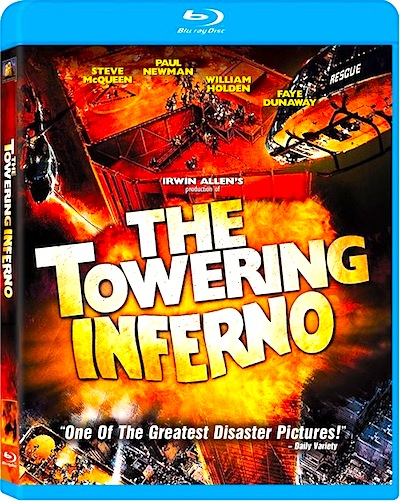 By Jason Apuzzo. The imagination sometimes wanders in unexpected directions. Govindini’s recent post on The Demise of bin Laden and The Cinematic Legacy of 9/11 put me in the frame of mind to revisit a favorite film of mine from years ago, a classic Hollywood action spectacle with eerie and unsettling echoes in the September 11th attacks: Irwin Allen’s The Towering Inferno, from 1974.
By Jason Apuzzo. The imagination sometimes wanders in unexpected directions. Govindini’s recent post on The Demise of bin Laden and The Cinematic Legacy of 9/11 put me in the frame of mind to revisit a favorite film of mine from years ago, a classic Hollywood action spectacle with eerie and unsettling echoes in the September 11th attacks: Irwin Allen’s The Towering Inferno, from 1974.
The Towering Inferno is, in my opinion, a genuinely great Hollywood adventure film – likely one of the best the industry has ever produced. It was certainly recognized as such in its day; the film was nominated for 8 Academy Awards, including Best Picture (it won 3 Oscars – for Cinematography, Editing and Best Song). What’s more, the film was a gigantic hit at the domestic box office – taking in around $116 million. What this means is that adjusted for inflation, the film would’ve grossed around $482 million today. (By comparison, the top film at the domestic box office in 2010, Toy Story 3, made $415 million.) Today the film is largely remembered for being the greatest of the 1970s era ‘disaster’ epics, but that probably puts the film in too narrow a box. There really are very few action films of its scale, energy or dramatic impact. The film also has the distinction of being the last great action film made by either Steve McQueen or Paul Newman, who co-starred in the film – and so for that reason alone, The Towering Inferno has a special place in cinema history.
Around 1973, just after the smash success of producer Irwin Allen’s The Poseidon Adventure, a bidding war erupted between Fox and Warner Brothers for a forthcoming novel called The Tower, which told the harrowing tale of a fire that breaks out in the world’s tallest building just as celebrities and dignitaries gather for its opening. The Tower, which I’ve read, is basically a morality tale set in a spectacular setting – in which we get to see how different types of people behave in the midst of a terrifying crisis.
Allen wanted to adapt the novel for Fox, but Warner Brothers outbid him for the novel. As luck would have it, a similar novel called The Glass Inferno – telling almost the same story – would also soon be coming out on the market, so Allen acquired the rights to that one. Allen then pulled one of the great producing maneuvers in Hollywood history: he called a summit between Fox and Warner Brothers, and got both sides to co-operate on an expensive joint project marrying the two novels into one film: The Towering Inferno, with a screenplay – a superb one, by the way – to be written by Stirling Silliphant. Thus was born the first major joint studio project in history. (As an interesting aside, years later James Cameron’s similarly expensive disaster epic Titanic would be another such joint venture, this time between Fox and Paramount.)
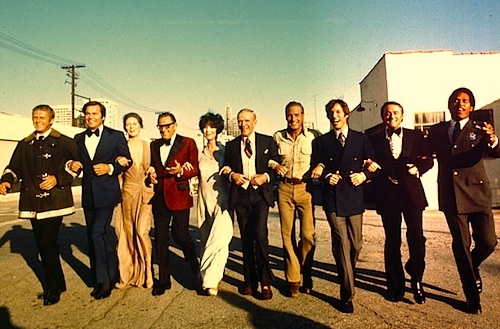
The film that resulted from this collaboration between these two major studios lived up to expectations – and to some extent surpassed them. A project that could easily have flopped, or spun out of control in a maelstrom of budget overruns, dangerous stunts and FX work – or out-of-control star egos – was put together by Irwin Allen in an atmosphere of crisp, military precision and professionalism.
The first big thing Allen did was assemble the film’s extraordinary cast, beginning with the improbable, blockbuster pairing of Steve McQueen and Paul Newman. More on that pairing below. Take a look at the rest of the cast, though, for Towering Inferno: Faye Dunaway, William Holden, Fred Astaire, Jennifer Jones, Richard Chamberlain, Robert Vaughn, Robert Wagner … and, of course, O.J. Simpson (he’s actually pretty good in his few scenes). Can you imagine a cast of this caliber appearing in a special effects picture today? It’s unimaginable.
The Towering Inferno came along at an interesting point in Hollywood history, when the technology of filmmaking had advanced to a point recognizably ‘modern’ to us today (Star Wars, for example, was only three years away) – while at the same time there was still a great class of old-fashioned Hollywood stars around to match the great effects, to lend a human dimension to the spectacular proceedings. Today we have the great visual effects, but do we have the stars with personalities to stand up to them? Or, to put the matter differently, Hollywood still understood back in the 1970s that stars themselves provided their own kind of spectacle – which is no doubt why a special scene was written into The Towering Inferno featuring the impossibly good-looking Paul Newman and Faye Dunaway in bed together. After all, back in the 1970s, that kind of thing qualified as major ‘action sequence.’
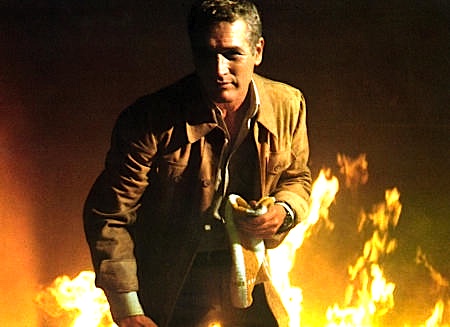
And so what was it that drew this magnificent cast to a disaster film? Certainly a lot of money was thrown at them, but just as importantly they were given a great storyline with distinctive, memorable characters. The Towering Inferno tells the story of a glittering, golden tower – the world’s tallest – built to dominate the skyline of San Francisco. The tower goes up in flames on the night of its opening gala – all due to faulty wiring installed by a corrupt contractor, played deliciously by Richard Chamberlain.
Paul Newman plays the building’s architect – a demanding, Howard Roark-style figure, who could easily have stepped right out of Ayn Rand’s The Fountainhead – and as the film begins he’s fed-up with his career and wants to get out of the big city. Newman’s safety specifications for the tower have been ignored by the building’s contractor, and Newman’s confrontations with the oily Chamberlain – a serial philanderer, besides being a corner-cutting liar – provide some of the film’s better early scenes. Faye Dunaway plays Newman’s glamourous girlfriend, who’s just gotten a plum job as managing editor of a major magazine. Having just gotten the job, she’s now reluctant to leave town, even with Newman trying to lure her away.
William Holden plays the tower’s builder, who’s also trying to keep Newman in town to build more skyscrapers. Robert Vaughn is Holden’s political muscle in town for the tower’s opening, Fred Astaire and Jennifer Jones play an elderly couple have a late-in-life romance, while Robert Wagner plays a smooth-talking p.r. man having a casual, 70s-style fling with his secretary. O.J. plays the building’s security chief, and spends a lot of the film tracking down a stray cat – back when The Juice seemed like a guy who would do that.
And of course, when all hell breaks loose as the tower goes up in flames, it’s none other than Steve McQueen who plays the San Francisco fire chief assigned to put out the colossal blaze.
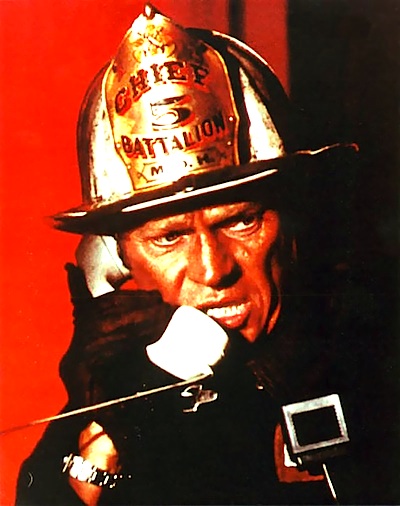
Newman and McQueen were the first major actors to sign onto the picture – both being at the time the biggest male stars in the world. McQueen was originally offered the role of the architect, but turned it down to play the more taciturn and heroic role of the fire chief. McQueen’s character doesn’t even appear in the film until about 45 minutes in, when he then begins his methodical work of saving the day. Until that time, the flashier and more emotional Newman has been carrying the film on his back, trying to prevent the fire outbreak with his wits rather than with a fire crew – and it can’t be stated enough here what a great performance Newman gives. Newman radiates charisma and integrity like a supernova – he’s funny, masculine, tender, and there are probably only 2 or 3 guys in the history of the movies who were as handsome as Newman in his prime. If you want to see a textbook case of a star carrying a big-budget picture, just watch Newman in The Towering Inferno.
Newman and McQueen had a kind of friendly, competitive rivalry going in the film. Both were famous at the time as celebrity race-car drivers. Both tried to out-do each other with pranks on the set. Both men received $1 million and 7.5% of box office to do the film, both were given exactly the same number of lines, and in an unusual arrangement both were given ‘top’ billing – and it all works. They’re both great, and The Towering Inferno is really the last big action film either guy did. It sort of goes without saying that the rest of the cast is great, as well. My favorites are probably Richard Chamberlain as the vain, selfish contractor – and the charming, urbane Robert Wagner as the tower’s p.r. officer.
Let’s face it, though: The Towering Inferno is really a Steve McQueen picture. The film gave McQueen a great opportunity to play one of his classic, stoic heroes – a consummate professional called in to handle a major crisis. The Towering Inferno opens with words of tribute to San Francisco’s firemen, but it’s really McQueen’s character who is the best tribute to firemen everywhere. McQueen brings his low-key intensity and humanity to the part, and really inhabits the part of Fire Chief O’Hallorhan. Never for a second do you think he’s just an actor doing this.

There’s actually a famous anecdote here with respect to McQueen, who trained intensely with Los Angeles firemen for the role. Just one week before The Towering Inferno started production, a major fire (unrelated to the film) broke out on the MGM lot. McQueen rushed out with the regular firemen, donned his boots, fire hat and jacket, and fought the blaze. As the story goes, one of the fireman did a double-take on catching sight of McQueen, and said: “Holy shit, Steve McQueen! My wife will never believe this!” McQueen replied, without missing a beat, “Neither will mine.” The press ate this anecdote up, and everybody wanted to interview McQueen about it – including Time. In his typically low-key way, though, McQueen would only grant one interview about it – to Fireman’s Grapevine, a trade newsletter for firemen.
Although The Towering Inferno runs a healthy 2 hours and 45 minutes long, it’s paced absolutely perfectly. We get a nice, gradual build-up to the conflagration, during which time all the characters and their problems are introduced. ***SPOILER ALERT*** The film’s ending is as spectacular as they come – with a million-gallon water tank at the top of the building blown up in order to (hopefully!) put out the fire. ***END OF SPOILERS*** Who will make it out alive? And who will plummet two thousand feet to their doom? Some major characters survive, others don’t.
There’s something quite primal about our fear of heights, a fear that The Towering Inferno trades on. Although the ‘villain’ of the film, so to speak, is the fire – it’s really the height at which the fire takes place, and the vertiginous drops from which characters meet their end, that gives the film its terrifying quality. These dizzying heights, filmed from multiple angles, are what give the film its special cinematic feel – particularly on a big screen. The tower in The Towering Inferno seems real yet unreal. It sticks out in the San Francisco skyline not unlike the way the World Trade Center stood out in New York. It’s almost begging to be a target. What’s the old phrase? “The nail that sticks out gets hammered down.”
On this point, it’s difficult to escape the conclusion that there is something unnatural, something awe-inspiring and exhilarating but also dangerous about the way mankind pushes itself upward into the heavens. This fear of mankind’s skyward ambitions as being somehow immoral, I suspect, is as old as the myths of the Tower of Babel, and of Icarus. Ayn Rand understood this phenomenon when she wrote The Fountainhead. And, I suspect, the now late and unlamented Osama bin Laden also understood this in choosing to target The World Trade Center. These extraordinary skyscrapers we were once so famous for erecting here in America (not so much nowadays) are part of what make us special, which is why every Middle Eastern potentate and Chinese industrialist these days is now racing to build one, themselves – an irony that bin Laden, who spent so much of his time in caves, must’ve found irritating.
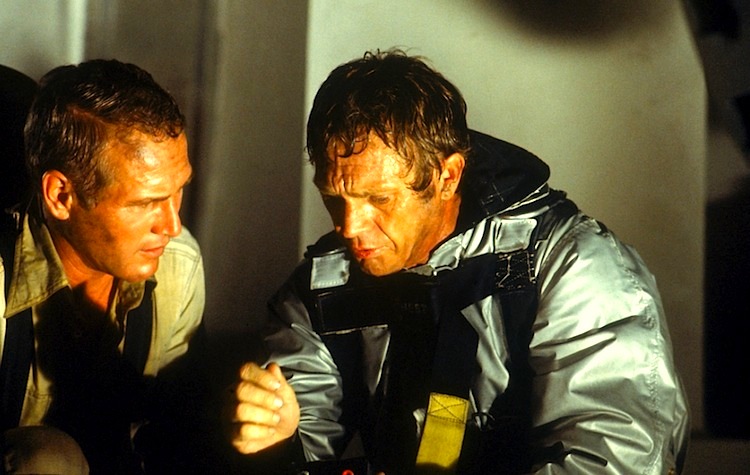
[Incidentally, Oliver Stone missed all of this when he made World Trade Center – a film that spends nearly all of its time lingering in the pit at Ground Zero. Stone’s film not only avoids the ideology that brought down the Towers, but mostly avoids the Towers themselves. All one need do is linger on their majesty to understand what a low, inhuman miscreant bin Laden was not only for killing so many people – but also for knocking those towers down. I’m not one of those people who thinks the Twin Towers were ‘ugly’ or unsightly. Having visited them personally, including Windows on the World, I can tell you that they were absolutely magnificent, ethereal, thrilling buildings – a testimony to everything that’s lifted mankind out of the primordial slime. This, I suspect, is why bin Laden was so obsessed with them. In contrast to World Trade Center, The Towering Inferno‘s tower set pieces are fantastic, even as the building goes up in flames. The building’s winding, modernist, cavernous interior – a bizarre, Dantesque world of twisted metal, fires and floods – is one of the most memorable aspects of the film.]
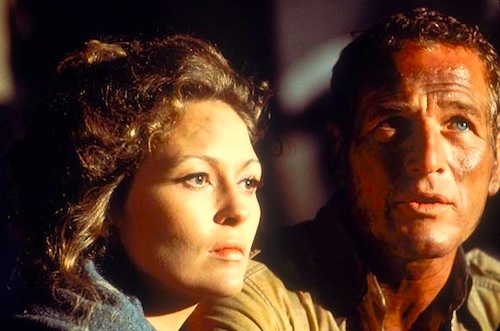
We’re pulled along in The Towering Inferno by John Williams’ buoyant, strikingly upbeat musical score – I think it’s one of Williams’ best, and he did it just a year before his big breakthrough with Jaws. Otherwise, The Towering Inferno’s dramatic scenes were directed by the underrated British director John Guillermin (The Blue Max, The Bridge at Remagen, King Kong, Death on the Nile), while Irwin Allen directed the spectacular action sequences. My favorite action sequence is the one in which a helicopter drops McQueen onto a stalled scenic elevator, dangling precariously off the side of the tower (the tower itself is erupting in flames and explosions). McQueen’s got to somehow cut the elevator loose, hook it up to the helicopter, and save a fellow firefighter all at once. It’s really something.
Speaking of McQueen, it should be noted that The Towering Inferno is a San Francisco movie, and that there are several connections with McQueen’s earlier San Francisco action thriller, Bullitt. The two films share five cast members, including McQueen, Robert Vaughn and Don Gordon – all of whom almost seem to be reprising their roles from the earlier film. A great double feature on a lazy Sunday afternoon by the Bay might be Bullitt followed by The Towering Inferno … hell, it beats watching Priest.
Much like The Poseidon Adventure, San Francisco, In Old Chicago and a lot of other great disaster epics, The Towering Inferno invites a certain amount of speculation as to whether the film is an allegory for something greater, an allegory for the state of American society, etc. Once the tower’s flames have been extinguished, lives have been lost, and all the main character arrive back on Earth (safely or otherwise) at the end, it’s tempting to ask what it all meant.
So here’s how the film ends, in essence: with Newman and McQueen agreeing that vaulting, ambitious buildings of this sort will continue to be built, but with fire safety in mind. Nobody decides to give up. Nobody decides to quit. The city will rebuild, but build a little smarter next time.
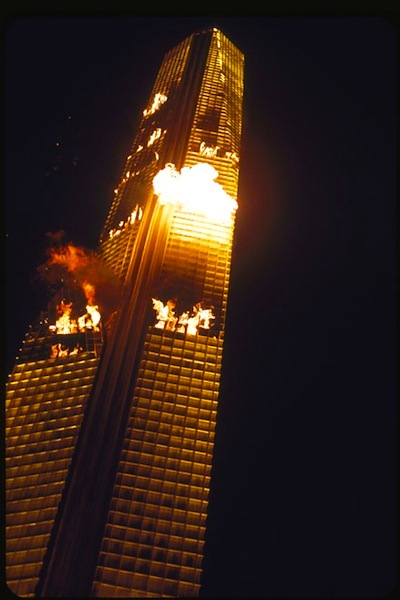
And here is where thoughts again turn to 9/11 and its aftermath. It bothered me to no end at the time that we didn’t begin to rebuild at Ground Zero immediately, in order to prove a point – that we’re not bowed or defeated, that we will not abandon our plans and ambitions. This is the second task America needs to complete, now that bin Laden is gone. We need to rebuild – even higher – what was destroyed.
Of course, it’s impossible to watch The Towering Inferno these days without thinking about 9/11. The film eerily replicates what the firefighters and trapped office workers in the Twin Towers must’ve experienced in the frantic hour after those attacks – although, weirdly enough, the fictional events depicted in The Towering Inferno almost seem more plausible than what actually happened on 9/11. Real life is so often stranger than fiction.
There are eerie connections between The Towering Inferno and the ultimate fate of the Twin Towers. First of all, both of the novels on which the film was based were inspired by the construction of the World Trade Center, and what might’ve happened if a conventional fire had broken out in one of those skyscrapers. In The Tower, for example, a fictional 140-floor building is built next to the North Tower of the World Trade Center – and the novel’s climax features a rescue mounted from the WTC North Tower. Plus, after The Towering Inferno was released, the film sparked a major controversy about the safety of high rises – a controversy that only intensified after a deadly fire subsequently broke out in one of the WTC’s towers. If that isn’t creepy enough, guess what day The Towering Inferno wrapped its principal photography?
September 11th, 1974.
You should watch The Towering Inferno, though, not because it’s ‘relevant’ to anything going on today, but because it’s a dramatic film with great characters and big emotions. It’s also ‘cathartic’ in the ancient Greek sense of being an exhilarating confrontation with – and harrowing overcoming of – death itself.
We’re all hoping the ‘fire’ that was recently extinguished by Navy SEAL Team 6 was not just that of Osama bin Laden’s life, but of Al Qaeda. Fires of that sort need to constantly be put out, if civilization intends to continue reaching for the sky.
Posted on May 14th, 2011 at 1:14pm.
“Today we have the great visual effects, but do we have the stars with personalities to stand up to them?”
Jason, that is one of the great questions that nobody is asking today. All anyone wants to do is blast the use of computer-generated visuals, as if it’s some sort of blasphemy to filmmaking. Little do most critics of the technique know, filmmakers like Francis Ford Coppola and Martin Scorsese — not just George Lucas, Steven Spielberg, and James Cameron — have embraced this for decades, and hailed the advancements as something that will redefine limitations in movie-making.
I remember seeing Terrance Stamp complain about blue-screen work while filming “The Phantom Menace,” but Ian McDiarmid responded by saying that it really challenges and inspires the actor because he has to envision the surroundings.
Your analysis regarding Tower of Babel and other myths are astute. I find the Ayn Rand connection particularly interesting, since she believed New York City represented the pinnacle of human achievement when she arrived here, so much so that she had to eventually move back there from California.
It’s a little embarrassing, but I don’t think I ever watch “The Towering Inferno” in its entirety — at least not since I’ve refined my literary palate a little.
Now I’m going to have to check it out immediately.
That is one epic piece of writing, man. Good job.
Many thanks, Vince, as always. I certainly hope you enjoy the film!
What’s happening a lot nowadays is that studios are pouring all of their money into VFX budgets, and saving money on the cast – hiring nobodies who can’t carry a film, and who are so appreciative of getting a role in a studio tentpole that they don’t demand any more with respect to the script. So everything’s out of whack.
McDiarmid’s completely right, by the way. Acting against a green screen is really no different than acting on the stage – it requires the same amount of imagination. What’s great about Towering Inferno, however, is that except for the big wide shots of the building, most of what you’re seeing is real – including when you’re seeing McQueen fight the fire. The stuntwork and live fire work on this film was phenomenal.
OK Jason, you have convinced me to watch it. I avoided it for many years as the all star cast genre from “How the West Was Won,” through aforementioned “The Poseidon Adventure,” bored the hell out of me. I found some of them to be quite irritating actually, and they often looked as if the stars and has been stars, and never were stars, just wanted the paycheck for as little effort as possible. On the other hand, McQueen, Newman and Dunaway can make any film interesting to watch. Just hope Red Buttons is not in it.
Just checked the cast and no Red. Also, one of the 1970s babes I used to lust for is in it-Susan Blakely…so it is a go!!
No, Red’s not in it! Inferno is infinitely better than Poseidon Adventure – in fact, I’ve never really understood why people like Poseidon Adventure so much.
As for Susan Blakely, she’s absolutely smoking … I’ve always wondered why she didn’t do more.
Actually, the Tower of Babel provoked judgment because men were trying to use it to make a national unity and prevent themselves from being scattered on the earth.
In a purely secular or euhemerean sense, theirs was the attempt to construct an identity around technology.
The semantic confusion of man resulted from reliance on technology rather than God (or if you are a humanist, man).
It would seem JA himself reenacts the part of God in condemning the replacement of actors with towering technological achievements.
It is ironic that as movies rely more on technology and less on man and God that their ability to communicate and generate ideals distintegrates.
JA remains close to his foundation after all.
Eric, is that you?
It’s me! I always enjoy the website.
Wonderful! Good to hear from you, E. Thanks so much for contributing, and best wishes to you and D.
I’m going to be in California this June. I’d love to invite you and G to dinner.
Wonderful … feel free to use one of the email buttons over to the right and shoot me a note – Best, Jason